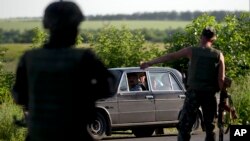MOSCOW —
Only six months ago, Russian President Vladimir Putin explained on state television why his government planned to give $16 billion in aid to the “brotherly” nation of Ukraine.
A Ukrainian government official proposed Friday building a 2,000-kilometer fence between Russia and Ukraine. Topped with barbed wire and electrified, the fence would be protected by ditches and anti-personnel mines.
The $130 million project proposed by Hennadiy Korban is far from becoming a reality. But it illustrates how hostile relations between the two bordering nations have become.
On Thursday, Ukraine’s new President Petro Poroshenko called Putin in the Kremlin to complain that three tanks had crossed into Ukraine to support pro-Russian separatists. Only days earlier, Putin publicly promised to completely seal the border.
But then on Wednesday, Russian Foreign Minister Sergei Lavrov acknowledged for the first time that Russia is sending cross-border aid to the rebels. He said it was “humanitarian.”
And, as if to prove the border has holes, Denis Pushilin, head of eastern Ukraine’s breakaway Donetsk People's Republic, popped up in Moscow this week. He met with nationalist politicians, appeared at a support rally, and gave interviews to Russian state television. In one, he said the rebels now have the three tanks - but he did not say where they came from.
In the interview, he made financial arguments for trying to take his region from Ukraine into Russia. He said his region pays far more in taxes to Kyiv than it gets in return.
Traffic through Russia’s so-called "closed" border goes both ways.
Oleg Tsarev, a fugitive member of Ukraine's parliament, told reporters in Donetsk this week that he was just back from Moscow, where he opened a fund-raising office for his pro-separatist People’s Front.
Thomas Graham, a director with Kissinger Associates, a New York-based consultancy, said in Moscow that a big question facing Putin is:
“The extent to which Putin, or the Russians, actually control the situation on the ground, to what extent have somewhat autonomous forces begun to operate that don’t have a desire to deal with Kyiv in a reasonable fashion,” he said.
Other analysts say Putin may be trying to create a permanent frozen conflict of the type now seen in Georgia, Moldova, Armenia and Azerbaijan. These secessionist conflicts keep Russia’s neighbors weak and give Russia a card to play.
Last week, Lavrov visited Finland, leading some analysts to speculate that the Kremlin’s goal is the “Finlandization” of Ukraine. Under this scenario, Ukraine would stay out of NATO, would commit itself to neutrality, and would be careful not to cross Russia’s interests.
For now, Ukraine’s new government shows no sign of bending to Russia.
As gas contract talks stumbled Friday, Ukrainian Prime Minister Arseniy Yatsenyuk ordered his government to prepare the nation for life without Russian gas. Faced with mounting unpaid bills, Russia has threatened to cut off gas supplies to Ukraine as early as Monday.
A Ukrainian government official proposed Friday building a 2,000-kilometer fence between Russia and Ukraine. Topped with barbed wire and electrified, the fence would be protected by ditches and anti-personnel mines.
The $130 million project proposed by Hennadiy Korban is far from becoming a reality. But it illustrates how hostile relations between the two bordering nations have become.
On Thursday, Ukraine’s new President Petro Poroshenko called Putin in the Kremlin to complain that three tanks had crossed into Ukraine to support pro-Russian separatists. Only days earlier, Putin publicly promised to completely seal the border.
But then on Wednesday, Russian Foreign Minister Sergei Lavrov acknowledged for the first time that Russia is sending cross-border aid to the rebels. He said it was “humanitarian.”
And, as if to prove the border has holes, Denis Pushilin, head of eastern Ukraine’s breakaway Donetsk People's Republic, popped up in Moscow this week. He met with nationalist politicians, appeared at a support rally, and gave interviews to Russian state television. In one, he said the rebels now have the three tanks - but he did not say where they came from.
In the interview, he made financial arguments for trying to take his region from Ukraine into Russia. He said his region pays far more in taxes to Kyiv than it gets in return.
Traffic through Russia’s so-called "closed" border goes both ways.
Oleg Tsarev, a fugitive member of Ukraine's parliament, told reporters in Donetsk this week that he was just back from Moscow, where he opened a fund-raising office for his pro-separatist People’s Front.
Thomas Graham, a director with Kissinger Associates, a New York-based consultancy, said in Moscow that a big question facing Putin is:
“The extent to which Putin, or the Russians, actually control the situation on the ground, to what extent have somewhat autonomous forces begun to operate that don’t have a desire to deal with Kyiv in a reasonable fashion,” he said.
Other analysts say Putin may be trying to create a permanent frozen conflict of the type now seen in Georgia, Moldova, Armenia and Azerbaijan. These secessionist conflicts keep Russia’s neighbors weak and give Russia a card to play.
Last week, Lavrov visited Finland, leading some analysts to speculate that the Kremlin’s goal is the “Finlandization” of Ukraine. Under this scenario, Ukraine would stay out of NATO, would commit itself to neutrality, and would be careful not to cross Russia’s interests.
For now, Ukraine’s new government shows no sign of bending to Russia.
As gas contract talks stumbled Friday, Ukrainian Prime Minister Arseniy Yatsenyuk ordered his government to prepare the nation for life without Russian gas. Faced with mounting unpaid bills, Russia has threatened to cut off gas supplies to Ukraine as early as Monday.









